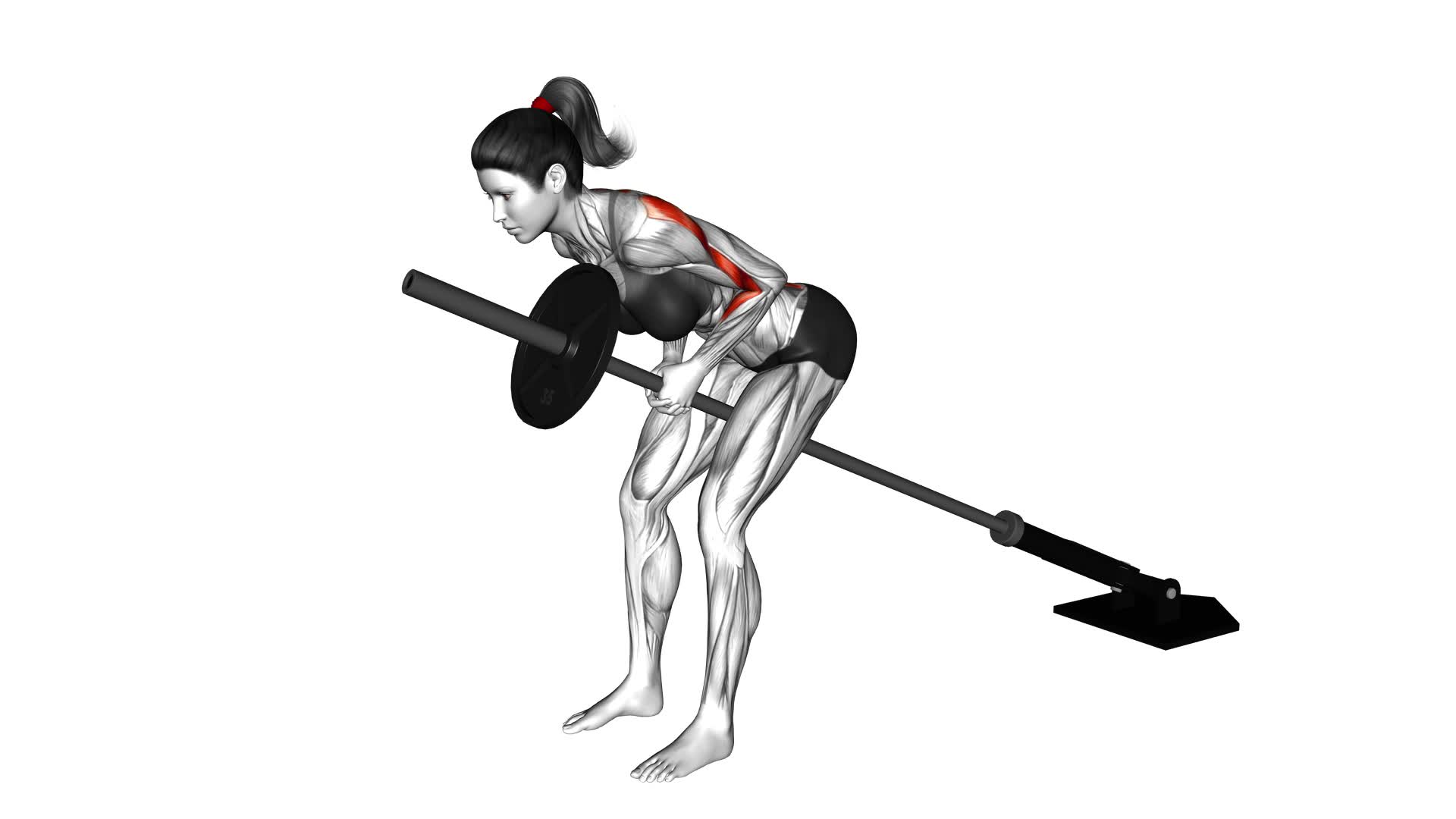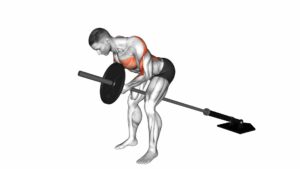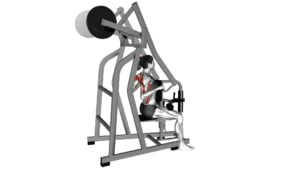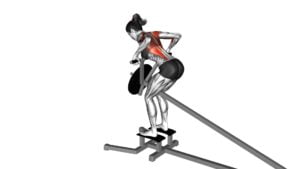Lever Bent Over Row (Plate Loaded) (Female) – Video Exercise Guide & Tips

Get ready to strengthen and tone your back with the Lever Bent Over Row. This video exercise guide is designed specifically for females, providing step-by-step instructions and tips to maximize your workout.
Watch This Exercise Video
Learn the benefits, proper form, and variations of this plate-loaded exercise. Avoid common mistakes and ensure a safe and effective workout.
Get ready to take your fitness to the next level with the Lever Bent Over Row. Let's get started!
Key Takeaways
- Lever Bent Over Row targets back muscles including latissimus dorsi, rhomboids, and trapezius.
- Proper equipment selection and setup technique are crucial for maximizing effectiveness.
- Safety precautions and proper form, such as maintaining proper body alignment and engaging core muscles, should be prioritized.
- Gradually increasing weight and repetitions allows for progression and stronger muscles.
Benefits of the Lever Bent Over Row
You will experience several benefits when incorporating the lever bent over row into your workout routine. This exercise primarily targets your back muscles, including the latissimus dorsi, rhomboids, and trapezius. By regularly performing this exercise, you can expect improved upper body strength, posture, and muscular endurance.
One of the key benefits of the lever bent over row is its ability to strengthen your back muscles. As you pull the weight towards your body, your back muscles contract, helping to build strength and definition. Additionally, this exercise also engages your biceps and forearms, providing an effective upper body workout.
Another advantage of the lever bent over row is the variety of variations and progressions available. You can adjust the weight load, hand placement, and grip style to target different muscle groups and add challenge to your workout. For example, using an underhand grip will emphasize your biceps, while an overhand grip will place more emphasis on your back muscles.
As you transition into the subsequent section about equipment and set up, it's important to ensure you have the proper equipment, such as a lever row machine or a barbell with weights. Setting up with proper form, including a stable stance and a neutral spine, is crucial for maximizing the benefits of this exercise.
Equipment and Set Up
To properly perform the Lever Bent Over Row exercise, you need to ensure that you have the correct equipment. Choose a lever machine that allows you to adjust the weight plates according to your fitness level.
Additionally, it's important to set up the machine correctly by adjusting the seat height and footrests for proper alignment and stability.
Lastly, always remember to follow safety precautions, such as using a spotter or setting the weight plates securely, to prevent any accidents or injuries during your workout.
Proper Equipment Selection
How do you efficiently select and set up the proper equipment for the Lever Bent Over Row (Plate Loaded) exercise?
Equipment selection is crucial to ensure proper form and maximize the effectiveness of your workout. When choosing the equipment for this exercise, opt for a lever machine that allows you to adjust the weight plates according to your strength level. Make sure the machine is in good working condition and properly maintained.
Before starting your workout, check that the weight plates are securely attached to the machine and do a quick test to ensure smooth movement. Additionally, ensure that the seat and footrest are adjusted to a comfortable position that allows you to maintain proper posture throughout the exercise.
Now that you have selected the right equipment, let's move on to the correct setup technique.
Correct Setup Technique
After selecting the proper equipment for the Lever Bent Over Row (Plate Loaded) exercise, it's important to ensure a correct setup technique for optimal results.
To start, adjust the height of the barbell to your mid-shin level. Stand with your feet shoulder-width apart, facing the barbell. Bend your knees slightly and hinge forward at the hips, keeping your back straight and chest up.
Grip the barbell with an overhand grip, hands slightly wider than shoulder-width apart. Engage your core and pull the barbell towards your lower chest, squeezing your shoulder blades together. Avoid rounding your back or using momentum to lift the weight.
Common mistakes to avoid include hunching your shoulders, using excessive weight, and neglecting proper form.
Safety Precautions to Consider
Ensure proper safety precautions are taken when setting up the equipment for the Lever Bent Over Row (Plate Loaded) exercise. To ensure your safety and maximize the effectiveness of the exercise, consider the following:
- Proper Body Alignment:
- Stand with your feet shoulder-width apart and knees slightly bent.
- Maintain a neutral spine by keeping your back straight and chest lifted.
- Engage your core muscles to stabilize your body throughout the exercise.
- Proper Breathing Technique:
- Inhale as you lower the weight, keeping your core tight.
- Exhale as you pull the weight towards your body, engaging your back muscles.
- Equipment Set Up:
- Adjust the seat height so that your feet are flat on the ground.
- Securely fasten the weight plates onto the lever bar, ensuring they're evenly distributed.
Proper Form and Technique
Maintain a strong, stable stance as you grip the barbell and initiate the pulling motion for the Lever Bent Over Row exercise. This exercise is highly effective for targeting multiple muscle groups in the back, including the lats, traps, and rhomboids, as well as the biceps and forearms. Proper form and technique are crucial to maximize the benefits of this exercise and reduce the risk of injury.
To perform the Lever Bent Over Row, start by standing with your feet shoulder-width apart and knees slightly bent. Keep your back straight and hinge forward at the hips, maintaining a slight bend in your elbows. Grip the barbell with an overhand grip, hands slightly wider than shoulder-width apart.
As you initiate the pulling motion, focus on squeezing your shoulder blades together and pulling the barbell towards your lower chest. Keep your elbows close to your body and avoid using momentum to lift the weight. Lower the barbell back down in a controlled manner and repeat for the desired number of reps.
To add variation and progressions to this exercise, you can try using different grip variations, such as an underhand or neutral grip. You can also increase the weight or perform the exercise on an incline or decline bench to target different areas of your back.
Remember to always maintain proper form and technique throughout the exercise to ensure optimal results and minimize the risk of injury.
Variations and Progressions
Try incorporating different grip variations, such as an underhand or neutral grip, to add variety and challenge to your Lever Bent Over Row exercise. By changing your grip, you can target different muscles and enhance your overall strength and muscular development.
Here are some variations and progressions you can explore to take your Lever Bent Over Row to the next level:
- Single-arm Lever Bent Over Row: Perform the exercise with one arm at a time to increase the demands on your core stability and unilateral strength.
- Wide grip Lever Bent Over Row: Widen your grip on the lever to engage your back muscles more effectively, particularly your lats.
- Incline Lever Bent Over Row: Adjust the bench to an incline position and perform the exercise. This variation places more emphasis on your upper back muscles.
Remember to start with a weight that challenges you but allows you to maintain proper form throughout the exercise. As you progress, gradually increase the weight or incorporate more challenging variations to continue challenging your muscles and promoting growth.
Don't forget to listen to your body and adjust the intensity and difficulty according to your fitness level and goals.
Common Mistakes to Avoid
When performing the lever bent over row, it's important to be aware of common mistakes that can lead to incorrect form and potential dangers.
One mistake to avoid is overloading the weight, as this can put unnecessary strain on your back and increase the risk of injury.
Additionally, neglecting a proper warm-up can also contribute to poor form and increase the likelihood of muscle strains or pulls.
Incorrect Form Dangers
To avoid potential injuries, be aware of the common mistakes that can occur when performing the Lever Bent Over Row (Plate Loaded) exercise. Incorrect form can lead to serious dangers and compromise your safety. It's crucial to prioritize proper technique to ensure a safe and effective workout.
Here are three key dangers of incorrect form and the importance of proper technique:
- Strain on the lower back: Failing to maintain a strong core and proper posture can put excessive strain on your lower back, leading to discomfort and potential injury.
- Shoulder and neck injuries: Incorrect form, such as rounding your shoulders or pulling with your neck, can put unnecessary stress on these areas, increasing the risk of strains or even tears.
- Limited muscle activation: Without proper technique, you may not be targeting the intended muscles effectively, resulting in limited gains and potential muscle imbalances.
Overloading the Weight
To prevent potential injuries and ensure a safe and effective workout, it's crucial for you to avoid overloading the weight while performing the Lever Bent Over Row (Plate Loaded) exercise. Overloading refers to using a weight that's too heavy for your current strength level or performing too many repetitions without proper rest. These overloading techniques can put excessive strain on your muscles and joints, increasing the risk of injury.
It's important to modify the intensity of the exercise by gradually increasing the weight and repetitions as your strength improves. This gradual progression allows your muscles to adapt and grow stronger over time. Neglecting to properly modify the weight and intensity can lead to overuse injuries and hinder your progress.
Now let's discuss another common mistake to avoid: neglecting proper warm-up.
Neglecting Proper Warm-Up
To prevent potential injuries and ensure a safe and effective workout, it's crucial for you to avoid neglecting proper warm-up before performing the Lever Bent Over Row (Plate Loaded) exercise.
Warm-up exercises prepare your body for the upcoming workout by increasing blood flow, warming up the muscles, and improving flexibility. Neglecting to warm up can lead to muscle strains, joint injuries, and decreased performance.
Here are three reasons why warm-up is important for injury prevention:
- Increased Blood Flow: Warm-up exercises increase blood flow to the muscles, allowing them to receive more oxygen and nutrients. This helps to prevent muscle cramps and improve overall performance.
- Improved Flexibility: Warm-up exercises loosen up the muscles and joints, increasing their flexibility. This reduces the risk of muscle pulls and strains during the Lever Bent Over Row exercise.
- Enhanced Performance: A proper warm-up prepares your body for the workout, allowing you to perform at your best. It increases your range of motion, power, and endurance, maximizing the effectiveness of the exercise.
Tips for a Safe and Effective Workout
- Ensure proper form and technique by keeping your back straight and engaging your core while performing the Lever Bent Over Row exercise. This is crucial for a safe and effective workout. By maintaining a straight back, you minimize the risk of injury and maximize the benefits of the exercise. Engaging your core helps stabilize your body and maintain balance throughout the movement.
- Start with a lighter weight and gradually increase the load as you become more comfortable and confident with the exercise. This allows your muscles to adapt and progress safely. Avoid using excessive weight that compromises your form and puts unnecessary strain on your body.
- Control the movement throughout the entire range of motion. Avoid using momentum or jerking motions as this can lead to injury. Instead, focus on a slow and controlled movement, emphasizing the contraction of your back muscles.
- Don't forget to warm up before starting your workout. A proper warm-up prepares your body for exercise by increasing blood flow to your muscles and joints, reducing the risk of injury. Include dynamic stretches and light cardio exercises to get your body ready.
- Lastly, listen to your body and know your limits. If something doesn't feel right or causes pain, stop immediately. Pushing through discomfort can lead to injury. Remember, safety should always be a priority in your workout routine.
Frequently Asked Questions
How Often Should I Incorporate the Lever Bent Over Row Into My Workout Routine?
To determine how often to include the lever bent over row in your workout routine, consider your fitness goals and overall program.
This exercise targets multiple muscles, including the back and core, and can help improve posture.
Aim to incorporate it at least once or twice a week, depending on your schedule and recovery ability.
Remember to start with proper form and gradually increase the weight as you progress.
Consult with a fitness professional for personalized guidance.
Can the Lever Bent Over Row Help Improve Posture?
Yes, the lever bent over row can help improve your posture. By targeting your upper back muscles, this exercise strengthens the muscles responsible for maintaining proper alignment and reducing slouching.
Improved upper body strength from the lever bent over row also contributes to better posture.
Additionally, this exercise provides benefits for overall muscle development, targeting multiple muscle groups in your back, shoulders, and arms.
Incorporating the lever bent over row into your routine can lead to better posture and overall strength.
Is It Necessary to Use a Plate-Loaded Machine for the Lever Bent Over Row, or Can I Use Dumbbells or a Barbell Instead?
Yes, you can definitely use dumbbells or a barbell instead of a plate-loaded machine for the lever bent over row. Using dumbbells or a barbell allows for more versatility in terms of weight selection and grip variations.
It's important to focus on maintaining proper form and engaging the targeted muscles during the exercise, regardless of the equipment used. Make sure to consult with a fitness professional to ensure you're performing the exercise correctly and safely.
Can the Lever Bent Over Row Help With Strengthening the Lower Back?
Yes, the lever bent over row can help with strengthening your lower back. By engaging your core and pulling the lever towards your body, you're targeting the muscles in your back, including the lower back.
This exercise can improve your overall back strength, which is important for preventing lower back pain and maintaining proper posture.
Incorporating the lever bent over row into your routine can be a beneficial addition to your workout regimen.
Are There Any Specific Muscle Groups That the Lever Bent Over Row Targets?
The lever bent over row targets specific muscle groups in your body. It helps to strengthen your back, including your lower back muscles, as well as your shoulders and arms. By performing this exercise, you can improve your posture and increase your overall upper body strength.
The lever bent over row offers numerous benefits, making it a great addition to your workout routine.
Conclusion
In conclusion, the lever bent over row is a beneficial exercise for women that targets the back muscles.
By using the proper equipment and maintaining proper form and technique, you can effectively strengthen and tone your back.
It's important to avoid common mistakes and follow the variations and progressions to challenge yourself and continue making progress.
Remember to always prioritize safety and consult with a professional for a safe and effective workout routine.

Author
Years ago, the spark of my life’s passion ignited in my mind the moment I stepped into the local gym for the first time. The inaugural bead of perspiration, the initial endeavor, the very first surge of endorphins, and a sense of pride that washed over me post-workout marked the beginning of my deep-seated interest in strength sports, fitness, and sports nutrition. This very curiosity blossomed rapidly into a profound fascination, propelling me to earn a Master’s degree in Physical Education from the Academy of Physical Education in Krakow, followed by a Sports Manager diploma from the Jagiellonian University. My journey of growth led me to gain more specialized qualifications, such as being a certified personal trainer with a focus on sports dietetics, a lifeguard, and an instructor for wellness and corrective gymnastics. Theoretical knowledge paired seamlessly with practical experience, reinforcing my belief that the transformation of individuals under my guidance was also a reflection of my personal growth. This belief holds true even today. Each day, I strive to push the boundaries and explore new realms. These realms gently elevate me to greater heights. The unique combination of passion for my field and the continuous quest for growth fuels my drive to break new ground.



